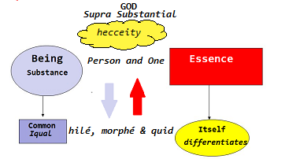
Hecceity, supra-substance and the divine
The pre-Socratics speculated: air, earth, ether (vacuum), fire, until the end of the Middle Ages it was speculated that everything was made up of phystis, a raw material for everything, but fire is only matter in combustion and what prevailed was Democritus’ (460 – 370 BC) primary model of the atom.
end of the Middle Ages it was speculated that everything was made up of phystis, a raw material for everything, but fire is only matter in combustion and what prevailed was Democritus’ (460 – 370 BC) primary model of the atom.
Aristotle formulated it as hilé (raw material) and morphé (form) which is also something divine beyond essence and substance, in a certain sense of appearance, also arché has the idea of the origin of all things and to which they return.
The myth Morpheus, whose etymological origin is Morphé, had the ability to appear in dreams and take on various forms of people, and on the question of what things are, the idea of quidity arises (quid – thing, what thing is, core).
Throughout the Middle Ages there remained a dialogue about quidity, which divided the nominalists and realists. Boethius is at the origin of the “quarrel of the universals”, about the idea of substance and essence. This dualism was broken up (perhaps resolved) with the hecceity of Duns Scotus, but he had formulated the theory of the supra-substantial, with something divine.
In Scotus’ hecceity, in addition to the reconciliation between essence and substance, there is a theme of profound relevance not only in the philosophical dispute between nominalists and realists of medieval scholasticism, but also among moderns, such as Heidegger and Deleuze, who used this category in their work.
The theme emerged in Boethius, both in his interpretation and translation of Porphyry and in his view of Aristotle’s Categories. His book Consolations of Philosophy was written in prison, having been unjustly accused in Rome’s palace intrigues, accused of treason by Theodoric and then executed, so his “consolations” refer in particular to his state.
Boethius’ writing follows a common pattern in the Roman period, where the Roman numbers indicate the chapters (or the book, in this case it could be CP, IA or IES) and the quotations indicate prose or poetry, a striking characteristic that gives his text a unique richness.
Poetry is used to express emotions and intensify the impact of reflections, and the alternation of styles, known as prosapoetry, is used to intensify the impact of his reflections and emotions, and in this book he elaborates on the supra-substantial, beyond the essentials and substances.
The question remains, from the atomic model we went to the subatomic, we penetrated the quarks and found phenomena and forms there that were smaller and smaller and more essential, the string theory that would explain even dark matter and black holes, suggests something like vibrations.
There could be something so divine in the whole universe that, despite not being found, its appearance suggests something supra-substantial, as Boethius theorized, and in it we update the question of the gods: what are we, where did we come from and what are the things of reality ? what are things?
The universe is a hologram, we’re in a “matrix”, it’s the structured strings.
Is there a supra-substantial divine structure as Boethius imagined the existence of God?
The existence of God as the body of the universe (Christocentric), as a supra-substantial Being, in the historical figure of Jesus, who also asks non-Christians: “Who do men say that I am?” (Lk 9:18-19, Mt 16:13-14, Mk 8:27-29) and they could not doubt his existence: “And who do you say that I am?” (Lk 9:20, Mt 16:15, Mk 8:30).
Boethius, A. (2016) Consolações da Filosofia. Transl. Luís M. G. Cerqueira. Portugal, Lisbon, Calouste Gulbenkian.









